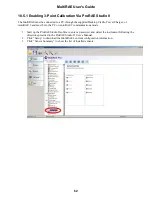
MultiRAE
User’s Guide
57
10.2.2
MultiRAE Lite Diffusion Model (No Pump)
Because there is no single inlet on the diffusion (non-pumped) version of the MultiRAE, a Calibration
Adapter is used for supplying calibration gas to all sensors at one time. Follow these steps for attaching
the Calibration Adapter.
Grasp the small handles on the
Calibration Adapter.
Align the Calibration Adapter’s
two connectors with the screws
on both sides of the MultiRAE’s
gas inlets.
Make sure the connectors are
securely in place before starting
the flow of calibration gas. (The
Calibration Adapter has small
grooves on its underside to allow
gas to escape after passing over
the sensors.
10.2.3 Bump (Functional) Testing
A bump test can be performed on an individual sensor (Single Sensor Bump) or a group of sensors (Multi
Sensor Bump) combined into Multi Cal. Select. The same gas is used for a bump test as for calibration.
Typically, two cylinders of calibration gas are needed to perform a bump test or calibration on an
instrument with a PID sensor and electrochemical and LEL sensors. This may require one gas cylinder
with Isobutylene or another VOC test gas to test the PID sensor, and another with a 4-gas mix to test
electrochemical (such as CO, H
2
S, and O
2
) and LEL sensors. As with calibration, the instrument
intelligently splits the process into two consecutive steps: first, the wizard prompts for testing
electrochemical and LEL sensors, and then it tests the PID sensor.
For a manual bump test, a constant-flow regulator producing 0.5 to 1 liters per minute should be used, and
the calibration cap must be installed on the instrument. Testing and calibration with an AutoRAE 2 must
be performed using demand-flow regulators. A calibration cap must not be used. Teflon tubing must be
used to test or calibrate the PID sensor. Follow the steps described here to perform a manual bump test:
1.
Turn on your MultiRAE by pressing and holding [MODE] (the middle button) and allow the
instrument to boot up fully until the main measurement screen with sensor names and readings is
shown.
Important!
Make sure all of the instrument’s sensors have warmed up before performing the bump
test. The instrument will take the time to warm up the sensors prior to enabling access to bump test
menus. You can tell a sensor has warmed up if you see a reading next to it name on the display. If it
has not warmed up, you see three dashes (“---”) next to it.
Calibration
Adapter
Hose to
Calibration
Gas
Source
Содержание MultiRAE
Страница 1: ...MultiRAE User s Guide Rev D December 2013 P N M01 4003 000 ...
Страница 92: ......
Страница 93: ...Rev D December 2013 P N M01 4003 000 ...
















































